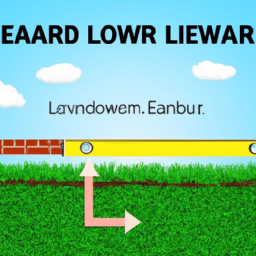How To Level Backyard
Table of Contents []
How To Level Backyard
Introduction
Creating the perfect backyard requires careful planning and a thorough assessment of your available resources so that you can have an outdoor space you can be proud of. It is essential to understand the elements needed and their function to maximize this area. The 8-12 key topics to level a backyard are: soil composition and drainage; assessing the slope; types of soil; specialty tools needed; terracing; grading; landscaping; and safety. Each topic will be discussed in further detail, offering tips on how to level a backyard.
Soil Composition and Drainage
Before beginning the leveling process, one important element to consider is the soil composition, and drainage is the first element to assess. Healthy soil filters rain and snow runoff and is less prone to erosion and nutrients loss, while a compact and hard soil has the tendency to become waterlogged and will require more maintenance. When establishing a backyard garden, check for appropriate drainage by digging a hole 2 feet deep and then refill it with water; the water should not remain in the hole for more than 4 hours. If water remains for longer, adding organic material and sand in the hole and bed may help improve drainage.
Types of Soil
When it comes to types of soil, there are three main categories; sandy, clay, and loam. Sandy soil is gritty and light, and it drains easily; it is perfect for growing herbs, vegetables, and other drought tolerant plants. Clay soil is sticky and heavy, aerating it with organic matter and other material can help improve drainage and add nutrients. Lastly, loam soil contains a balanced mix of sand, clay, and silt, it is a type of soil that is perfect for gardening.
Specialty Tools Needed
When leveling a backyard space, some tools such as a shovel, a hoe, and a rake will come in handy for removing rocks and weeds. Depending on the size and type of level desired, using a tamper or a rototiller can help to level the bed. Having a water source or a garden hose close can help the process as well. Coordinate the tools and find the best option before starting the leveling process.
Terracing
Terracing can assist in creating a level and appealing backyard. This is the process of cutting into a hillside, which can be done manually by using a shovel or with the aid of machines. Use equalizer beams and forked stakes when building a terrace wall, while soil and rocks are great material for stacking the layers. Building terraces can help with the transition from a higher to a lower level and add depth when designing the backyard space.
Grading
Grading the yard is the process of redistributing soil and is essential for a proper drainage system. This step is performed with either a rake or a power tool (such as a grading blade) in order to create a level area that is properly prepared for landscaping. Areas to be graded should be surveyed to verify the elevation of the land and the fall direction. Additionally, ditch drainage can be used to lower the elevation.
Landscaping
When landscaping, think about the plants, dwarf trees, and shrubs that fit the look you are going for. Incorporate indigenous plants that require less water and maintenance. Xeric plants are a great choice as they don't need a lot of water and can be planted in areas with considerable lighting; wildflowers and ornamental grass are suitable and can add a great look and layout to the yard.
Safety
Finally, safety should be a priority. When leveling and landscaping the space, beware of any overhead or underground utilities, consider using safety gear, and protect your skin and eyes from contaminants in the soil or dust in the air. Furthermore, create a plan to secure the area from possible wild animals, and use of a secure gate or a deer-resistant fencing may be needed.
Summary
It is important to take time to plan and assess the available resources before beginning any project, and it is no different for a backyard. Eight to twelve key topics can offer guidance to level a backyard, such as soil composition and drainage, assessment of the slope, types of soil, specialty tools needed, terracing, grading, landscaping, and safety. Understanding these topics and applying them can result in an outdoor space to be admired and enjoyed for years to come.
Final Thoughts
Backyard curating is becoming increasingly popular as it allows for an outdoor space that fits individual needs and wants. Employing the topics discussed in this article and combining them with creativity and originality can transform a regular backyard into an amazing area that can be enjoyed from year to year.

Previous Page
